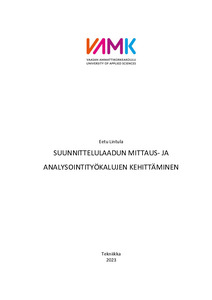Suunnittelulaadun mittaus- ja analysointityökalujen kehittäminen
Lintula, Eetu (2023)
Lintula, Eetu
2023
All rights reserved. This publication is copyrighted. You may download, display and print it for Your own personal use. Commercial use is prohibited.
Julkaisun pysyvä osoite on
https://urn.fi/URN:NBN:fi:amk-202305078099
https://urn.fi/URN:NBN:fi:amk-202305078099
Tiivistelmä
Tämän opinnäytetyön toimeksiantaja on Vaasan ABB IEC LV Motors -yksikkö. Opinnäytetyö tehtiin sovellussuunnitteluosastolle. Opinnäytetyön tarkoituksena oli kehittää sovellussuunnittelun suunnittelulaadun mittausta, analysointia ja raportointia siten, että niiden avulla voidaan havaita juurisyyt suunnitteluvirheille. Suunnitteluvirheitä vähentäviä toimenpiteitä voidaan tehdä, kun havaitaan niiden juurisyyt.
Opinnäytetyön teoriaosuudessa tutustutaan yritykseen ja oikosulkumoottoreihin, tutkitaan sovellussuunnittelua ja sovellussuunnitteluprosessia, laatua sekä sen eri työkaluja ja menetelmiä. Teoriaosuuden jälkeen tutkitaan ja analysoidaan saatavilla olevaa tutkimustietoa suunnitteluvirheistä, minkä pohjalta aletaan kehittämään suunnittelulaadun mittaus- ja analysointityökaluja. Työ etenee teoriaosuudessa tutkitun DMAIC-ongelmanratkaisumallin mukaan. Tutkimustiedon analysoimisessa käytettiin teoriaosuudessa tutkittuja laatutyökaluja.
Työn keskeisiä tuloksia ovat suunnitteluvirheiden uusi virheluokitus, uusi ulottuvuus mitata suunnitteluvirheitä sekä suunnitteluvirheiden raportoinnin kehitys. This thesis was assigned by ABB IEC LV Motors unit in Vaasa. The thesis was done for design engineering department. The purpose of this thesis was to develop measurement, analysis and reporting of engineering quality in such a way that root causes for engineering related defects can be detected.
The theoretical part of the thesis introduces ABB Oy, short-circuit motors, design engineering process, various quality methods and tools. The topics of theoretical part were studied with help of various materials and literature. After theoretical part, the research data of engineering related defects was analysed. Measurement and analysis tools were developed based on analysed research data. The thesis proceeded according to the DMAIC-process which is introduced in the theoretical part of the thesis.
The main results of the thesis are new defect type classification, a new method to measure engineering related defects and developed reporting page for engineering related defects.
Opinnäytetyön teoriaosuudessa tutustutaan yritykseen ja oikosulkumoottoreihin, tutkitaan sovellussuunnittelua ja sovellussuunnitteluprosessia, laatua sekä sen eri työkaluja ja menetelmiä. Teoriaosuuden jälkeen tutkitaan ja analysoidaan saatavilla olevaa tutkimustietoa suunnitteluvirheistä, minkä pohjalta aletaan kehittämään suunnittelulaadun mittaus- ja analysointityökaluja. Työ etenee teoriaosuudessa tutkitun DMAIC-ongelmanratkaisumallin mukaan. Tutkimustiedon analysoimisessa käytettiin teoriaosuudessa tutkittuja laatutyökaluja.
Työn keskeisiä tuloksia ovat suunnitteluvirheiden uusi virheluokitus, uusi ulottuvuus mitata suunnitteluvirheitä sekä suunnitteluvirheiden raportoinnin kehitys.
The theoretical part of the thesis introduces ABB Oy, short-circuit motors, design engineering process, various quality methods and tools. The topics of theoretical part were studied with help of various materials and literature. After theoretical part, the research data of engineering related defects was analysed. Measurement and analysis tools were developed based on analysed research data. The thesis proceeded according to the DMAIC-process which is introduced in the theoretical part of the thesis.
The main results of the thesis are new defect type classification, a new method to measure engineering related defects and developed reporting page for engineering related defects.
